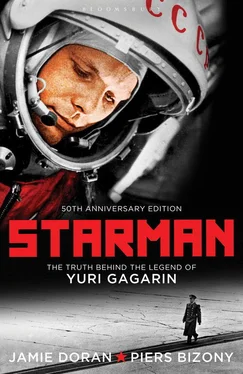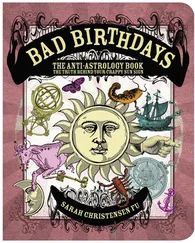This was the first Soviet fatality during an actual space flight, and it came as an immense shock; nor could the basic truth of the disaster be discreetly hidden from the outside world (although the Soviet authorities admitted only to an unfortunate parachute failure, and not to a series of design and preparation flaws dating from long before the ship took off). This time it was NASA’s turn to send letters of condolence. Both sides in the superpower divide had learned that the space environment showed no concern for nationalities or flags, but treated all trespassers – Russian and American alike – to the same set of risks.
Three weeks after Komarov’s death, Gagarin met Russayev at his family apartment, but refused to speak in any of the rooms because he was worried about bugs – listening devices buried in the walls or hidden in light fittings and telephones. The lifts and lobby areas were not safe either, so the two men trudged up and down the apartment block’s echoing stairwells and along the corridors. Anything to keep moving and confuse the eavesdroppers.
The Gagarin of 1967 was very different from the optimistic and carefree young man of 1961. Komarov’s death had placed an enormous burden of guilt on his shoulders. ‘He told me the story about the huge research effort undertaken to try and prevent the flight,’ says Russayev. ‘He said the results were supposed to have been reported to the Main Man [Brezhnev]. He explained how they’d thought of me as an envoy in charge of getting the letter to the relevant offices. I told Yuri how I’d worked on it, and everything that had happened… He warned me, “Walls have ears.” It was Yuri’s idea to avoid the lifts. Somebody must have told him my apartment was bugged… I found out for sure when my wife woke me up at three in the morning, and we both heard a rustling behind the ventilation grille where they were installing the bug. The thought of it made me furious. How could they bug one of their own agents? I suppose that’s the essence of Soviet life. There were always so many bugs around.’
At one point Gagarin said, ‘I must go to see the Main Man personally. Will he see me, d’you think?’
Russayev says, ‘I was amazed he could ask me this. I said, “But Yuri, you’re the one who’s always standing next to him on the Mausoleum. You’re always chatting together, and now you’re asking me if I can tell you whether or not he’ll see you? I haven’t even shaken the guy’s hand.”
‘“Yes, but I never talk seriously with him. All he ever wants to do is hear dirty stories and jokes from all my foreign trips.”’
Gagarin was profoundly depressed that he hadn’t been able to talk properly to Brezhnev and persuade him to cancel Komarov’s launch. As Russayev explains today, ‘Relations between Khrushchev and Gagarin were absolutely excellent, but with Brezhnev it wasn’t so good. If people don’t want you, it can be hard to get through.’
Shortly before Gagarin left, the bitterness and intensity of his anger became obvious. ‘I’ll get through to him [Brezhnev] somehow, and if I ever find out he knew about the situation and still let everything happen, then I know exactly what I’m going to do.’
Russayev goes on, ‘I don’t know exactly what Yuri had in mind. Maybe a good punch in the face.’
Russayev warned Gagarin to be cautious as far as Brezhnev was concerned. ‘I told him, “Talk to me first before you do anything, and I’ll try to advise you. I warn you, be very careful.” But I wasn’t in the space department any more. I wasn’t even in Moscow, so there wasn’t much I could do. I don’t know if Yuri ever got to see Brezhnev, and I’ve felt guilty ever since that I couldn’t stay with Yuri to guide him.’
One story has it that Gagarin caught up with Brezhnev eventually and threw a drink in his face.
Although Gagarin grieved for Komarov, who had always been one of the ablest and most likeable cosmonauts, he remained as determined as ever to fly, and was extremely disappointed when his superiors decided to ground him from further rocket flights. Alexei Leonov explains, ‘After Komarov, the State Committee decided it wasn’t possible to fly Yura, because all the problems with the Soyuz had to be corrected, and it was going to take two years to redesign the vehicle.’
It was not just the slippage in the launch schedule, but renewed nervousness at the possibility of losing Gagarin to an accident, that contributed to his grounding – and there were certain military traditions to uphold. Sergei Belotserkovsky reluctantly agreed with the decision to ban the First Cosmonaut from further missions. Although he is well aware that Gagarin desperately wanted a moon flight, he says, ‘The main candidate [for a possible lunar attempt] was Andrian Nikolayev. Regarding Yura, Korolev told me shortly before his death that he probably shouldn’t fly any more. Yura was in a difficult situation, because he was Deputy Director of the Cosmonauts’ Training Centre, and the responsibilities of that job are clearly laid out – the control and training of other cosmonauts. It’s not usual for the chief of a training centre to make flights himself.’
Gagarin was very depressed by this decision, and wrote a letter to the State Committee in which he pleaded, ‘I can’t be prevented from flying. If I stop flying, I will have no moral rights to lead other people whose life and work are connected with flying.’
With the straight-talking wisdom of an honest working man, Gagarin’s favourite hairdresser Igor Khoklov says, ‘Yuri couldn’t live without flying. It was his whole life. A man can’t live without his trade. He can’t survive.’
When the redesigned Soyuz finally flew successfully for the first time, on October 26, 1968, Gagarin’s harshest critic, Georgi Beregovoi, was at the controls.
The truth behind Komarov’s accident and Gagarin’s grounding is only now coming to light, but most Western analysts knew by now that something was wrong with the First Cosmonaut’s career. As long ago as 1982, in his ground-breaking book Red Star in Orbit , the American space writer James Oberg wrote:
There was Yuri, transformed before his death at thirty-four from a personable, cocky jet pilot into a demi-god to be worshipped, emulated and protected from all risk and adventure, until his own attempts to break out from the protective walls around him went just a little too far.
Gagarin diverted himself with more partying, prompting a disappointed Kamanin to note, ‘Since Komarov’s death, Gagarin has been dismissed from all space flights. He has undergone a new, more stormy process of personality disintegration.’
At the beginning of March 1968, the last month of Gagarin’s life, a comfortable accommodation centre for cosmonauts was at last completed in Star City. Alexei Leonov remembers some hard partying, perhaps triggered by the cosmonauts’ desire to block out the emotional horror of Komarov’s terrible death. ‘We probably met at Gagarin’s apartment more often than anybody else’s place. The traditions of hospitality were already established, from where we lived before, at Chkalovsky. There was this law – if you arrived late for a party you had to strip down to the waist and get into a bath of cold water and submerge your head. Even famous people had to go through this. The law was the law! Actually this was a tradition started by Yuri, and the point was that after a cold bath you were revived with a big jolt of vodka so as not to catch a cold. The trouble was, everybody started to turn up late to get their vodka.’
One distinguished guest was the architect Komarovsky, responsible for the tall tower at Moscow State University, where the first cosmonauts had been dropped down the lift-shaft back in 1960. He was welcomed with an ancient peasant gesture of hospitality, still observed by modern Russians, even those aboard the Mir space station: gifts of vital foodstuffs to protect the traveller against hunger. ‘We took Komarovsky up to the top floor, where there was some bread and salt and vodka,’ says Leonov. ‘Then from the eleventh floor down to the tenth, where there was more bread and salt and so on, all the way down through every floor. Komarovsky, and some other famous people, they said at the end of all this, “Well, we’ve seen many extraordinary things in our lives, but never so much bread and salt!” Anyway, that’s how we thanked the people who built our apartments.’
Читать дальше












